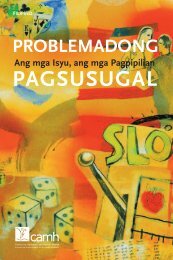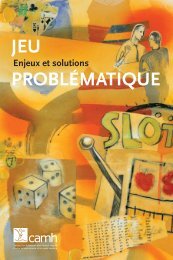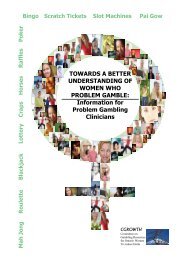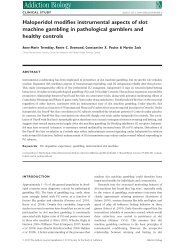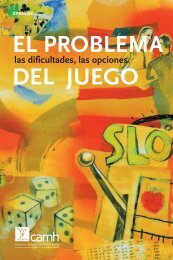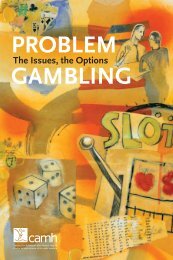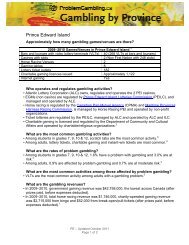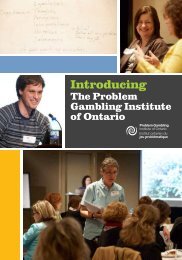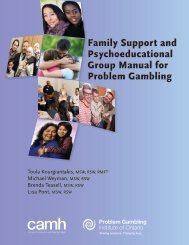Youth Making Choices: Gambling Prevention Program
Youth Making Choices: Gambling Prevention Program
Youth Making Choices: Gambling Prevention Program
Create successful ePaper yourself
Turn your PDF publications into a flip-book with our unique Google optimized e-Paper software.
Unit 4: What Is Problem <strong>Gambling</strong>?Appendix BTeacher Resource 1 p. 3At the same time though, most adolescents are going through lots of changes, so a downwardshift in function is normal. What isn’t normal is if that downward shift continues.Healthy youth don’t usually get into trouble with the law or sneak out for secretive meetings withpeople they meet through Internet chats. They don’t regularly post inappropriate pictures ofthemselves online or lose sleep from spending excessive hours glued to their computer. Theydon’t end up becoming inebriated and driving under the influence, have blackouts, engage inrisky sexual activities and so on.The key to knowing if an activity has become a problem is that the youth will start to functionless well in one or more spheres of her life. While people often try to define Internet orvideogame “addiction” based on the number of hours spent on the activity, what really counts iswhat that amount of time does to the person, for example:• <strong>Youth</strong> A plays three hours a day of online chess. This youth still gets good grades at school,maintains his friendships, eats and sleeps well and so on.• <strong>Youth</strong> B plays seven hours a day (mostly at night) of online role-playing games. This youthhas disrupted her sleep cycle, and this begins a chain of consequences including arriving atschool late and marks beginning to suffer.• <strong>Youth</strong> C plays 20 minutes a week of online poker. He often steals one of his parents’ creditcards. He usually breaks even but recently he lost over $8,000 in the span of 10 minutes.In the end, if risk-taking behaviours begin to interfere with a youth’s social, academic, vocational,psychological, physical or interpersonal spheres, this is of major concern. If risk taking becomesa major ongoing pattern of behaviour, it may indicate the presence of a physical or mental healthdisorder or family issues, or both, for example, substance use, gambling, depression, trauma,ADHD, etc.References1Paglia-Boak, A., Mann, R.E., Adlaf, E.M., & Rehm, J. (2009). Drug use among Ontario students,1977–2009: OSDUHS highlights. (CAMH Research Document Series No. 28). Toronto, ON:Centre for Addiction and Mental Health.2National Institute of Mental Health. Press Release May 17, 2004, Imaging Study Shows BrainMaturing. http://www.nimh.nih.gov/science-news/2004/imaging-study-shows-brain-maturing.shtml<strong>Youth</strong> <strong>Making</strong> <strong>Choices</strong>: <strong>Gambling</strong> <strong>Prevention</strong> <strong>Program</strong>www.Problem<strong>Gambling</strong>.ca4.17




